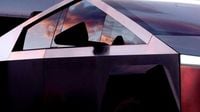In the early hours of November 27, 2024, a devastating crash in Piedmont, California, brought renewed scrutiny to Tesla’s much-hyped Cybertruck—and cast a harsh spotlight on the company’s controversial door design. What started as a late-night drive for four recent graduates of Piedmont High School ended in tragedy when their electric pickup slammed into a retaining wall and then a tree, erupting into flames. Three of the young occupants—19-year-old Krysta Tsukahara, 19-year-old Soren Dixon (the driver), and 20-year-old Jack Nelson—lost their lives. Only one, Jordan Miller, managed to escape, thanks to the quick-thinking actions of a bystander who smashed the windshield with a tree branch.
According to lawsuits filed by the families of Tsukahara and Nelson, the crash’s aftermath revealed a fatal flaw in the Cybertruck’s design: its high-tech, handleless doors, powered by a 12-volt battery, failed completely once the vehicle lost power. The lawsuits, as reported by the San Francisco Chronicle, Carscoops, and Daily Mail, allege that this system—marketed as cutting-edge—became a deathtrap in the chaos of a crash. The electric door release system failed, and the manual override, hidden beneath a rubber mat in the second row, was nearly impossible to find in the smoke and darkness. As a result, Tsukahara, who survived the initial impact and was fully conscious, was trapped inside the burning vehicle. She ultimately died from smoke inhalation and burns, unable to escape despite being alive and aware in her final moments.
“It’s just a horror story. Tesla knows that it’s happened and that it’s going to happen, and they are doing nothing but selling the car with a system that entraps people and doesn’t provide a way of extraction,” said Roger Dreyer, the Tsukahara family’s attorney, in comments to the San Francisco Chronicle. The lawsuits accuse Tesla of showing a “conscious disregard” for consumer safety, citing more than 30 publicized examples of similar problems with Tesla’s door systems. Both wrongful death suits—filed by Tsukahara’s and Nelson’s parents—are seeking unspecified punitive damages against Tesla, as well as damages from the driver’s and vehicle owner’s estates.
The design of the Cybertruck’s doors, which open and close at the push of a button, is emblematic of Tesla’s approach to automobile innovation: bold, futuristic, and sometimes, critics argue, heedless of basic safety concerns. The lawsuits claim that the lack of a “functional, accessible, and conspicuous manual door release mechanism [or] fail-safe” directly contributed to the deaths of the trapped passengers. Tesla, which was added to the Tsukahara lawsuit in October, did not immediately respond to requests for comment, according to multiple outlets.
The Daily Mail reports that Krysta’s father, Carl Tsukahara, expressed anguish over the circumstances of his daughter’s death. “Krysta was a bright, kind, and accomplished young woman with her whole life ahead of her. We’ve had to endure not only the loss of our daughter, but the silence surrounding how this happened and why she couldn’t get out. This company is worth a trillion dollars, how can you release a machine that’s not safe in so many ways?” he said, echoing the frustration felt by many families who have lost loved ones in similar incidents.
Tragically, the crash was not a simple case of product failure. The California Highway Patrol’s investigation determined that impaired driving and speeding were significant factors. All four victims had cocaine, alcohol, and other substances in their systems, and the driver, Soren Dixon, registered a blood alcohol level of 0.195—more than twice the legal limit. Still, the victims’ families and their attorneys argue that, regardless of the crash’s cause, the inability to escape the burning vehicle was a preventable tragedy. “It’s a preventable death if you have a vehicle occupant who dies who otherwise could exit a vehicle if their doors were functional, or be rescued,” said an attorney for the Nelson family, as reported by Carscoops.
The lawsuits against Tesla are not occurring in a vacuum. The company’s vehicles have been the subject of ongoing safety concerns, particularly regarding their innovative but sometimes problematic door mechanisms. In September, the National Highway Traffic Safety Administration (NHTSA) announced an investigation into Tesla after owners of 2021 Model Y SUVs reported that the doors would not open—forcing some parents to smash windows to free their children. The Cybertruck itself, launched with great fanfare in November 2023, has already faced more than half a dozen recalls and reports of plummeting sales, as noted by the San Francisco Chronicle.
What’s perhaps most chilling is that this tragedy in California is not isolated. The Daily Mail details a similar incident in Villigst, Germany, in September 2025, where a shop owner desperately tried to save a man and two children trapped in a burning Tesla after its retractable door handles failed. Despite his frantic efforts, he was unable to open the doors and pull the victims to safety. “I wanted to save people,” he said, haunted by the memory. In that case, too, the manual release was either inaccessible or unknown to would-be rescuers, leading to more preventable deaths.
For Tesla, these lawsuits and investigations strike at the heart of its brand promise: that innovation and safety can go hand-in-hand. Critics argue that the company’s relentless pursuit of futuristic design has sometimes come at the expense of basic, time-tested safety features. The lawsuits allege that Tesla has long been aware of the risks posed by its electronic door handles, but failed to implement meaningful fixes or educate consumers about the location and use of manual overrides—especially in high-stress, low-visibility situations like a post-crash fire.
“This lawsuit is about truth and accountability. The design of this vehicle failed Krysta. There was no functioning, accessible manual override or emergency release for her to escape. Her death was preventable,” said Dreyer, the Tsukahara family’s attorney, to the Daily Mail. The sentiment is echoed by other families and advocates who believe that, while driver error may have caused the crash, the inability to escape should never have been a death sentence.
As the legal battles unfold and the NHTSA’s investigation continues, the tragedy in Piedmont has become a rallying point for those demanding that automakers—no matter how cutting-edge—prioritize the basics of occupant safety. The haunting questions linger: How many more lives must be lost before simple, reliable manual door releases become standard? And will Tesla, and the industry at large, heed the lessons of these heartbreaking stories?
For now, the families of Krysta Tsukahara, Jack Nelson, and Soren Dixon are left to mourn their loved ones and seek justice in the courts, hoping their efforts might spare others from similar fates in the future.



